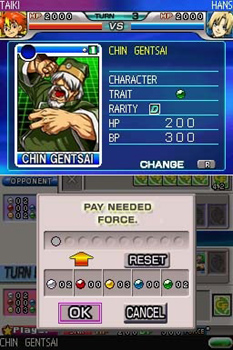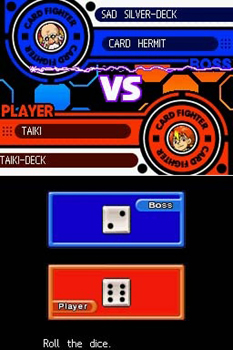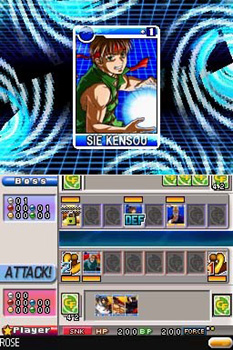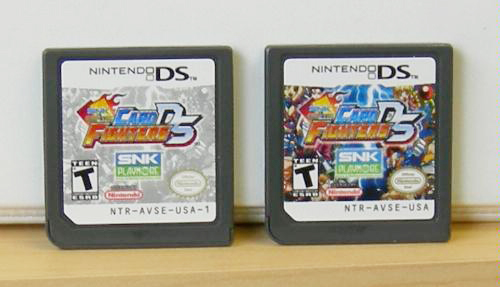|
SNK vs. Capcom Card Fighters DS By: PoisonRamune, the Apathetic Lizardman When I was in junior high and early high school I was really into collectible card games. I’ll admit, I bought most of the games based on the card artwork or theme of the game (I’m looking at you Star Wars CCG) and learned how to play a little less than half of them. I personally believe that the problem with a lot of early CCGs was the fact that they tried too hard not to be like Magic the Gathering (the first CCG that attained notable market success). While being original is a good thing, card game developers were seemingly trading playability for originality far too often. Perhaps that’s why I really like SNK vs. Capcom Card Fighters DS, since it plays like a lighter, faster version of Magic the Gathering. Though I say it’s like a light Magic the Gathering; it’s not some sort of picture card version of High Card like Yu-Gi-Oh, you’re actually going to need some strategy to win.
The game is very easy to learn; following the format of nearly every CCG under the sun, you’re basically going to be using your cards to deplete your opponent’s life points. Your cards come in 3 types: character, action, and counter cards. Characters are the Phoenix Wrights, Ryus, Terry Bogards, Mai Shiranuis, etc that you’ll be using to attack your opponent and defend against their attacks; they’re basically the same as creature cards from fantasy themed CCGs, except they’re based on Capcom and SNK licenses. Aside from just being storm troopers in your video game based army, many character cards also have a bonus action that can be activated for a few extra force points. The bonus actions are normally perks such as adding extra hit points to the character and are most often activated only when the character cards is first played; however, there are a few exceptions to this where the bonus is on going or can be activated at anytime (most notable is R. Mika’s annoying bonus of gaining 100 attack points every turn).
Action and counter card should make up a very small percentage of your deck (about 10% or 5 cards total), as they’re basically cards that are used to heavily sway the momentum of the game. These types of cards do things such as: making a given character card unblockable, healing characters of the fight damage they’ve taken, or out right killing a given character on the board (this one has saved my sorry butt several times so far); so you can see why there’s such a low frequency of these available. They also add a good deal of strategy to the game, since you can choose to play your actions and counters immediately giving you a discouraging lead against your opponent or you can save them and use them to ensure victory in one solid strike. The only difference between action and counter cards are which turn you’re allowed to play them; action cards can only be played on your turn and counter cards are played during your opponent’s attack phase. Casting each card is kind of weird and interesting in itself, since each character card generates a designated amount of colored force points (the in game summoning currency). You start the game off with 3 white force points and gain more by discarding a card from your hand, in turn gaining its output yield of force points. Or you can play (ring-in) a character and collect its force output yield at the start of your next turn (and subsequent turns). The computer normally takes the role of a rusher, sacrificing cards as quickly as possible to get hard hitting characters out early. However, I found the best counter is to take a few hits early on and slowly build your character army. By the third turn or so they’ve probably discarded so many cards from their hand that it’s hard for them to get any new blockers/attackers out, giving you the perfect chance to attack a defenseless opponent.
The interface is well designed here; the cards, player information and game statistics are all very easy to find and read. The tower map in story mode is a bit primitive and looks more like something you’d find in a Gameboy Advance game; however, this can be forgiven as it’s really only used to go on to your next battle and to visit a shop or card trading NPC for new cards. The card art is really bizarre in a cool way. Sometimes characters just look like their in game sprites, other times they look like stylized concept art, and a very small percentage are done in this creepy, photo realistic style. The most notable victims of this weird art anomaly are the Ace Attorney cards: Edgeworth looks pretty much as he does in the Ace Attorney games, Mia Fey looks like she had some weird acrylic paint effect/filter applied to her, and Phoenix looks like an Asian man in a blue suit. It’s very disturbing and appealing all at the same time. The music actually doesn’t suck in this game. In fact, it’s very Capcom and SNK sounding. So the music is some of the most well produced generic and non-descript tracks you’ll ever hear. I would have hoped for the inclusion of some remixes on classic game series music, with this being a joint venture between Capcom and SNK. If there were tangible cards made for this game, I’d probably start buying them in a heartbeat. The game is fun, easy to get into, and has one of the coolest themes for a game of this type. I highly recommend this game for anyone that wants a really good digital CCG/TCG or anyone that loves games by SNK and/or Capcom. Sidenote: You may or may not have heard that this game was extremely glitched when it was first released. As of 2 years ago the glitch has been fixed, but there are still broken copies in the used game stores. To prevent picking up an unplayable copy, I’ve included a picture to help you distinguish the difference between and glitched copy and a fixed copy of this game (special thanks to the random person on Amazon that posted this originally).
|




